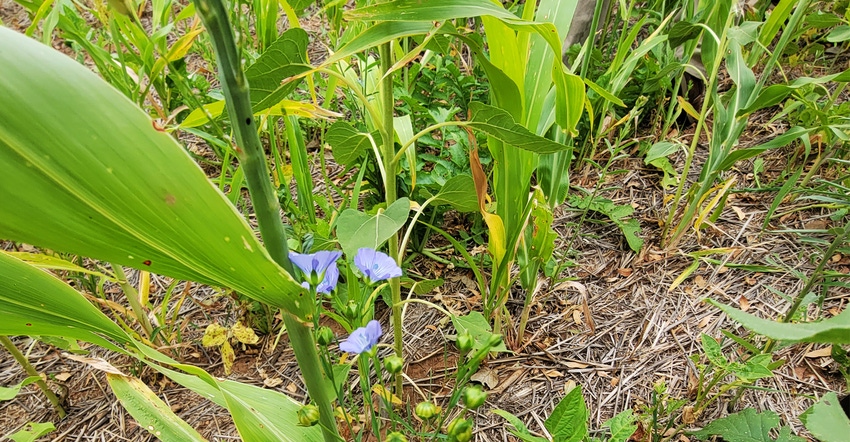
“With the concerns of excess carbon dioxide in the atmosphere, increasing soil carbon may have an economic benefit to farmers beyond crop production,” says Julie Howe, associate professor, Texas A&M University and Texas A&M AgriLife Research, College Station, Texas. Howe, in a presentation to the Texas Plant Protection Association annual meeting in December, explained that increasing plant residues left in and on the soil and decreasing practices that stimulate degradation are important to build coil carbon. Soil carbon is a critical aspect of sustainable agriculture, especially with carbon derived from plant residues, she said.
Benefits include better aggregation of soil particles, which reduces erosion, increased water holding capacity, and enhanced infiltration.
Soil carbon is a source of slow-release nutrients and holds applied nutrients. It also stimulates microbial processes that can benefit crop production.
Cover crop advantages
Using cover crops to maintain soil cover and following recommended fertilization practices, along with minimizing tillage, can help build soil organic carbon, Howe said.
She discussed two AgriLife research projects she’s conducting that evaluate cover crop advantages.
“One evaluates and compares cover crop options in a small plot trial. The other is a larger-scale evaluation of two cover crops and fallow that will eventually be managed with and without grazing.”
She said research will focus on the cover crop itself and the impact to the soil and the subsequent cash crop. The overall goal is to evaluate the potential for limited-term (or flash) grazing, which could offer producers opportunities to recoup expenses associated with cover cropping.
See, Put soil health in consultant’s toolbox
Howe said cropping systems typically consist of one crop per year with three to five months fallow, during which no new carbon is added. During fallow, carbon is lost to the atmosphere as microbes degrade residues, and bare soil is exposed to destructive rainfall. Loss of carbon and exposure causes soil structure to deteriorate causing infiltration and water holding capacity to decrease and potential for erosion to go up.
That’s not what producers want in sustainable agriculture.
Limiting carbon loss
Cover crops limit those losses. “Cover crops contribute to soil organic carbon (SOC),” Howe said. “Belowground biomass (roots) creates paths for water movement when they die. Biomass contributes to SOC, and the aboveground biomass (residue) protects soil surface from wind and rain.”
She said cover crops are not harvested, so the carbon remains in the soil.
See, Driver receives TPPA's Norman Borlaug Lifetime Achievement Award
Howe said research studies in Central Texas evaluated different cover crops including the effect on biomass, soil properties, compaction, infiltration, and SOC.
The study also looked at the potential for grazing the cover crop, including evaluating forage quality, biomass, and soil cover. Results from the first year indicated that 20% small grains (i.e., oat/cereal rye) and 80% legumes (winter pea and vetch) had the greatest potential for generating biomass, providing quality forage, covering the soil, and contributing to soil carbon.
A field trial evaluated the impact of a cover crop on corn.
Treatments included fallow, small grains (50/50 oat/cereal rye), small grains and legume mix (50% oat/cereal rye; 50% Winter pea).
Results
Although “initial observations following planting showed that corn germination was delayed in cover crop treatments, and corn plants were smaller during the first few weeks, at R2 we saw no difference in plant height, no difference in corn leaf greenness (SPAD), no difference in soil moisture, and no difference in weed cover. We saw no difference in yield at harvest.”
See, Caveats on cap-and-trade carbon markets
She said research did not evaluate soil moisture since the spring season was wet.
Tillage challenges
Howe said tillage in cover crops reduces SOC. "Tillage enhances residue decomposition, exposes SOC to microbial attack, decreases aggregate size, and increases soil-residue contact.”
On the other hand, decreasing tillage increases the benefits.
See, Soil ‘next frontier’ to achieve carbon goal
“Reducing tillage intensity increased SOC (Both systems used cover crops.),” she said, referencing some of her previous research.
Fertility issues
Managing fertility with cover crops can be challenging. Howe said when fertilizer improves biomass production, SOC increases. But excess nutrients reduce SOC gains.
Added nitrogen feeds microbial activity and lowers the carbon/nitrogen ratio of residue.
Cover crops protect the soil, add SOC, reduce reliance on added nutrients, water, and tillage, and add biodiversity. “Avoid excessive fertilization,” Howe said. “Soil test.
See, Develop strategies for healthy soil
She said SOC is an important part of sustainable farming but tends to decrease under conventional production agriculture. “SOC benefits sustainable production with improvements in nutrient cycling, water dynamics, and reduction in soil bulk density (compaction).
She offered several practices to improve SOC.
Minimize soil disturbance (reduced tillage)
Maximize biological diversity (crop, animal and microbial)
Maintain living plants (crops, cover crops and native vegetation)
Maintain soil cover (residue and mulch)
Howe also recommends looking for ways to offset the initial costs to plant and maintain cover crops. That could include limited grazing.
Read more about:
Texas Plant Protection AssociationAbout the Author(s)
You May Also Like






